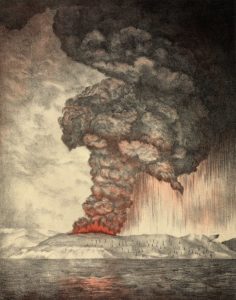1883 Krakatoa blows its top
The volcano on the island of Krakatoa in the Dutch East Indies had been unusually active for months in 1883, with numerous earthquakes and eruptions of ash and smoke. On the morning of August 27, 1883, these activities reached an astonishing and deadly climax. In four enormous explosions, the island self-destructed with consequences felt around the planet.
The first two explosions set off tsunamis that raced, as tall as 90 feet high, toward neighbouring islands. The third and fourth explosions may have made more noise than anything else in recorded history; they were heard in Australia and India, causing listeners 3,000 miles away to think they were hearing gunfire; they ruptured the ear drums of sailors on ships 40 miles away. The energy released in the final explosion tore the mountain apart; it has been estimated to have been many times more powerful than the largest hydrogen bomb exploded by humans. The air waves ripped around the globe several times and were still being felt days later.
The damage was breath-taking; the tsunamis and lava eruptions killed tens of thousands of inhabitants in the Indies. The clouds of ash that poured forth caused the sky to darken for years and produced sunsets so red and vivid that fire departments in North America were summoned to put out what were thought to be local fires. For months, the moon seemed to be blue or green and a ring was observed around the sun. The ash spewed into the skies reflected more sunlight than usual, causing global temperatures to drop and altering weather patterns for years.

Despite the title of the 1968 disaster movie Krakatoa, East of Java, the island is, in fact, west of Java.

My mom took me to see this movie when it came out. I was six … and found it really boring. (Gimmie a break … I was just a kid.)